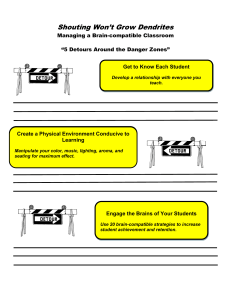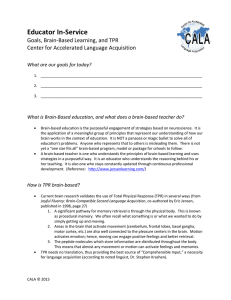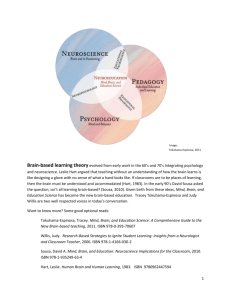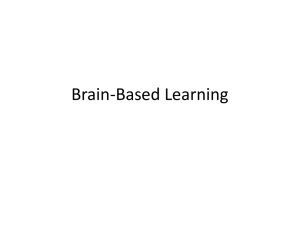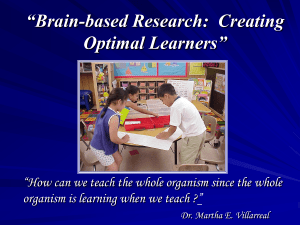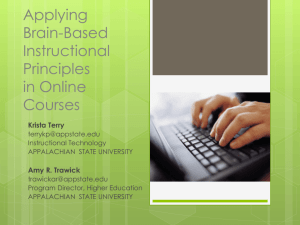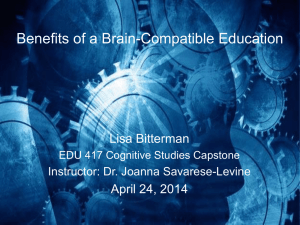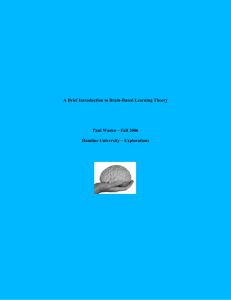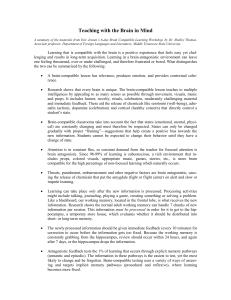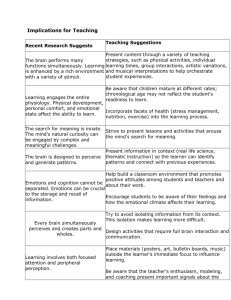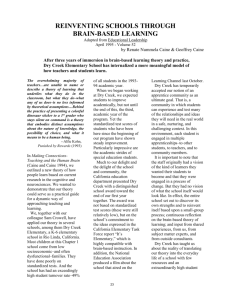Brain-Based_Learning_PP_F05
advertisement
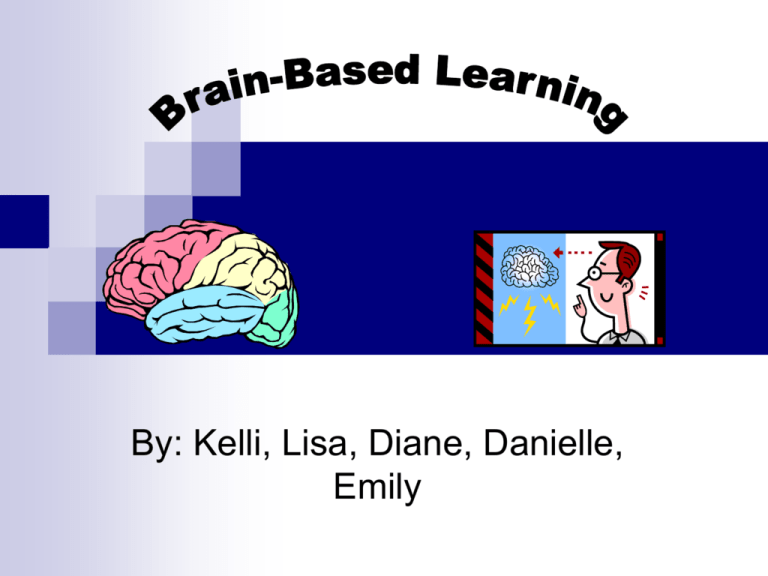
By: Kelli, Lisa, Diane, Danielle, Emily The brain is “hard-wired” to do… Vision Language Attention Emotion Motor skills All of these are stimulated through individual experiences. What do we know about how the brain learns? The brain is a vastly complex and adaptive system with hundreds of billions of neurons and interneurons that can generate an astronomical number of neural nets, or groups of neurons acting in concert, from which our daily experience is constructed. Experience affects the brain’s potential and keeps modifying the brain for learning. The brain thrives on activity. Brain research has confirmed that emotions are linked to learning by assisting us in recall of memories that are stored in our central nervous system. The brain learns best when confronted with a balance between stress and comfort. What are some general understandings about how the brain works? The brain is a parallel processor. It does many things at one time. Learning engages the entire physiology. The brain is an organ that functions according physiological rules. The search for meaning is automatic. This is survival oriented and basic to the human brain. The search for meaning takes place by patterning. The brain is designed to perceive and generate patterns, and it resists having meaningless patterns imposed on it. Emotions are critical and at the heart of patterning. We do not simply learn things. What we learn is influenced and organized by emotions. The brain processes parts and wholes simultaneously. There are significant differences between the left and right hemispheres of the brain; however, in a healthy person the two hemispheres are interactive. Learning involves both focused attention and peripheral perception. The brain absorbs information of which it is directly aware and information that lies beyond the field of attention. Learning always involves conscious and unconscious processes. We learn much more than we ever consciously understand. What are some general understandings about how the brain works..Cont. We have at least two different ways of organizing memory: a spatial system and a set of systems for rote learning. The spatial system does not need rehearsal and allows for instant memory of experiences. Facts and skills that are dealt with in isolation are organized differently. Our brains have a system to store unrelated information. We understand and remember best when facts and skills are imbedded in natural, spatial memory. Items are given meaning when embedded in ordinary experiences. The brain downshifts under perceived threats and earns optimally when appropriately challenged. Under threat the brain will narrow the perceptual field. The brain learns best when the atmosphere is low in threat and high in challenge. Each brain is unique. The same sets of systems are integrated differently in every brain. The brain changes with learning so the more we learn the more individual we become. Activity Optical Illusion-Brain Teaser Activity-Brain Quiz Please take the Brain Quiz to see if you are more left or right brained! Results Left Brain Good at remembering names Right Brain Good at remembering faces Likes to do several things at once Likes to do things one at a time Likes to keep feelings to himself/herself Is not a risk-taker, careful, does not like to make mistakes Likes to let people know how he/she feels Is good at thinking up funny things to say and do High tolerance for clutter, disorganized Fairly long attention span, good listener Short attention span, daydreamer Will ask many questions before making a decision Likes to guess at the answer in problem solving situations What are some of the implications of what we’re learning about the brain for teaching and the school environment? Elementary schools should provide classes for five year olds of no more than 10 or 12. Teachers should construct learning programs which combine in the child's mind as well as theirs an understanding of both content and process in ways which make children's thinking visible to themselves. This will significantly change the role of the teacher making it essential for them to model the very techniques of good learning that children will need for themselves. While good teachers will remain essential it is clear that successful learning for all will require substantially more than just the technology of teacher, chalk and talk. As a policy, investment in the technologies of learning should increase with the child's age. Implications Chart Recent Research Suggests Teaching Suggestions The brain performs many functions simultaneously. Learning is enhanced by a rich environment with a variety of stimuli. Present content through a variety of teaching strategies, such as physical activities, individual learning times, group interactions, artistic variations, and musical interpretations to help orchestrate student experiences. Learning engages the entire physiology. Physical development, personal comfort, and emotional state affect the ability to learn. Be aware that children mature at different rates; chronological age may not reflect the student's readiness to learn. Incorporate facets of health (stress management, nutrition, exercise) into the learning process. The search for meaning is innate. The mind's natural curiosity can be engaged by complex and meaningful challenges. Strive to present lessons and activities that arouse the mind's search for meaning. The brain is designed to perceive and generate patterns. Present information in context (real life science, thematic instruction) so the learner can identify patterns and connect with previous experiences. Emotions and cognition cannot be separated. Emotions can be crucial to the storage and recall of information. Help build a classroom environment that promotes positive attitudes among students and teachers and about their work. Encourage students to be aware of their feelings and how the emotional climate affects their learning. What does current brain research have to do with classroom learning? One thing you’ll never find is a single, definitive study that "proves" brainbased learning is better. Why? You would have to do the following: 1. Train teachers in brain-based learning, then insist and guarantee that they’ll use the strategies during the study. (That won’t happen) 2. Have a "control" school to compare with that is using NO brain-based strategies. That would mean a school with threats, constant confusion, mismatched curriculum, no arts, P.E. or fair social structure. Teachers would be unskilled, all lecture and no processing time for the kids. (What parent would allow their kids in that school?) 3. Create a fair assessment. What do you want to assess? Do you want higher state and federal mandated test scores? Or do you want a healthier, happier, more self-reliant human being with confidence, lifelong learning skills and a sense of fairness, honesty, confidence, humility and in support of diversity? (That assessment won’t happen). 4. Use double blind and longitudinal studies. Ones in which neither the researchers or the classroom students or the teachers knew which methods were being used. That can’t happen— it’s too obvious and the teacher methods would bias the results. Doing studies over time is better but who would fund this—these take hundreds of thousands of dollars to fund. In short, none of this will happen. Who are some current researchers in the area of the brain and learning, and what unique positions do they take? Eric Jensen: co-founder of SuperCamp, The Brain Store, and Jensen Learning Corporation. He is a member of the Society for Neuroscience and New York Academy of Science. He is author of over 22 books including Brain Compatible Strategies, Principle-Driven Learning, and Brain-Based Learning. Renate Caine: Dr. Caine received her Ph.D. in Educational Psychology at the University of Florida. She is co-author of the book Making Connections: Teaching and the Human Brain. She and her husband Geoffrey Caine founded the Caine Learning Institute in California. The institute is dedicated to “expanding the family of those working with the Brain/Mind Learning Principles. David Sousa: Dr. Sousa received his masters in teaching at Harvard and hid Doctorate at Rutgers University. Dr Sousa is an international educational consultant and has published numerous articles in leading educational journals on science education and brain research. How can teachers utilize in the classroom current information about how the brain learns? For example, it is said that much of what we learn comes to us indirectly. What does that say about a “stand and deliver” style of teaching? Present-day teachers are extremely unique in that the research done on the brain and how we learn continues to progress. However, this information provides greater responsibility for educators in that they now have the knowledge to reach the various forms of learners that enter their classrooms. If classrooms are to be places of learning, then the brain should be understood and accommodated. In “What is Brain-Based Learning” by Lisa Chipongian, she quotes Leslie Hart (author of Human Brain and Human Learning) who argues the importance of brain-based learning: “All around us are hand-compatible tools and machines and keyboards, designed to fit the hand. We are not apt to think of them in that light, because it does not occur to us that anyone would bring out some device to be use by human hands without being sure that the nature of the hands was considered. Continued.. A keyboard machine or musical instrument that called for eight fingers on each hand would draw instant ridicule. Yet we force millions of children into schools that have never seriously studied the nature and shape of the human brain, and which not surprisingly prove actively brain-antagonistic.” Hart also argued that if educators used brain-based learning more frequently, then the school would become an exciting center where there is a constant encounter with the richness and variety of the real world as opposed to those classrooms that are almost empty of anything real one might learn from. What would a brain-compatible classroom look like? What would brain-compatible instruction be like? (a chart comparing a brain-compatible classroom and a brain-antagonistic classroom) Brain-Antagonistic Classroom Brain Compatible Classroom Teacher threatens with rewards and punishments Absence of threat Learning is individual Appropriate emotional arousal Low emotional impact Global, unified, thematic, real life Fragmented, sequential study Utilizing and expressing energy Suppressing learner energy Multiple intelligences served Lecture, more didactic Emphasis on context, meaning Subjects taught separately Often rich with talking, activity Emphasis on quiet learning Intrinsic motivation evoked Forced driven by grades Best learning difficult to measure Delayed, indefinite, vague feedback Use of totally positive language Out-come based, mandated learning Search for questions Quest for a single answer Music, sights, aromas, movement Starve the brain for stimulation Learner input on topics Brain-Antagonistic Classroom Single topic only by presenter choice Teach for the test, with stress Extended presenter lecture time Finish when time’s up Belief that learning is difficult Infer, tell, demand Abrupt exposure to topic Sit at desk and limit interactions High stakes testing Minimal opening and closing time Brain Compatible Classroom Learn for joy of learning and life Alternate focus activities Finish with celebration Easy, fun, creative Suggest, tell, ask Purposeful, consistent exposure Mobility, partners, groups Realistic, multiple assessments Long open/close, shorter middle Brain-compatible Instruction Use metaphors like cartoons, stories, and broad, general representations of context. Use color. Don’t use it to a distracting and excessive level. The learner has to be able to figure out why you are changing the colors and what patterns you are using. You can use a new color for each point or one color for heading and another for details. Use a graphic organizer. The right-brained students need it and the others like it. Present similar information that can be easily confused at least a day apart. On the second lesson, when introducing similar but different material, emphasize the differences. Change the method of presentation every 10 or 15 minutes to refresh the cycle of learning. Find out what motivates your students and apply the topic to that area of interest when possible. One-third of kids learn best when they are in motion. Walk with them and get them moving. Make sure you have sunlight or full-spectrum light in your classroom. Add a desk lamp, open the blinds, and enjoy the light which changes the chemicals your nervous system secretes. Keep the lights on whenever possible. Dimming lights or turning lights off during a video promotes the release of chemicals in the brain that makes students sleepy. Use music and motion in classroom lessons. Students’ learning is affected by five main factors: Immediate environment 2. Own emotionality 3. Sociological preferences 4. Physiological characteristics 5. Processing inclination 1. What factors inhibit learning? Too much stress Limited activities and options Lack of motivation Activities that don’t connect to students’ lives Constant failure Lack of support Rigid Instruction Paper/pencil assessments Attitudes that limit learning for all kinds of learners: There is usually one correct answer and one best way of finding it. Students will have an opportunity to show what they know on the test. Faster is better. Doing things faster means you are smarter. Mistakes mean you haven’t learned or studied carefully enough. The best students are independent. They don’t need or ask for assistance. There are some things that individual students just can’t learn. Some students just don’t have what it takes. It’s not fair to make accommodations just for some students. Attitudes that promote learning for all kinds of learners: There are many different ways to learn. There are advantages to thinking in different ways. All students can become capable, achieve at a high level, and improve in an area of weakness. There are many ways to succeed. Students will have many opportunities and ways to show what they have learned. It is not how quickly but how well you learn that counts. Mistakes are natural steps in learning and can point the way to success. Good students are interdependent. They ask for and give help. Students can improve, even in their areas of weakness. How can I encourage learning in the classroom? Learner-centered environment Variety of activities Reasonable number of choices and opportunities Cater to different learning styles and multiple intelligences Help students succeed Challenging but attainable goals Encourage risk taking, creativity, and ingenuity Be caring and cooperative Provide safe environment Motivate every student (internal locus of control) Allow students to share their ideas and how they solved the problem Real-life applications Integrated learning Group work Link indoor and outdoor places Quotes “The closer the match between students’ learning styles and their teachers’ teaching styles, the higher the grade point average.” “Discipline systems that focus on behavioral consequences of rule infractions distract students from the real business of classroom learning and are themselves doomed to failure because of negativity.” “When a classroom is run on children's natural motivation, emphasis is on learning and being part of the environment, not on rewards and other external reinforcers that take away from the essentials of school.” “Children learn better and remember more when their studies are mixed with music and drama, experience, emotion and realworld context. The more regions of the brain that are involved and the more we engage our emotions, the more means we have for recalling information.” Bibliography The Brain-Compatible Classroom www.buffalostate.edu Hemispheric Dominance Inventory Test: Brain Wave Entertainment Technology www.brain.web-us/brain/braindominance.com Southwest Educational Development Laboratory-How can research on the brain inform education? http://www.sedl.org/scimath/compass/v03n02/brain.html 21st Century Learning Initiative-Learning to Go with the Grain of the Brain http://www.21learn.org/publ/edcanada.html 12 Design Principles Based on Brain-based Learning Research By Jeffery A. Lackney http://www.designshare.com/Research/BrainBasedLearn98.htm Hitchhiker’s Guide to Brain Science http://drawingwriting.com/HichHike.html#Tip1 The Brain-Compatible Classroom – General Characteristics www.xnet.rrc.mb.ca D’Arcangelo, M. (November 1998). The Brains Behind the Brain. Educational Leadership, 56 (3), 20-25. Retrieved November 9th, 2005, from the World Wide Web: http://www.ascd.org/portal/site/ascd Knowledge of Student Characteristics. (2001). INTIME. Retrieved November 9th, 2005, from the World Wide Web: http://www.intime.uni.edu/model/teacher/teac1summary.html Bibliography Cont. Do You See What I’m Saying? The Role of Gestures in Learning by Sara Latta, July 2000 www.brainconnection.com What is Brain-Based Learning? by Lisa Chipongian, 1999 www.brainconnection.com http://courses.fgcu.edu/~189/upload/Right-Left Brain Exploration(1).doc http://www.brainconnection.com/ http://jlcbrain.com/what.html What & Who is Jensen Learning? http://cainelearning.com Who are We? http://www.mainesupportnetwork.org/handouts/html/Approach.htm Understanding a Brain-Based Approach to Learning andTeaching. http://www.corwinpress.com/author.aspx?aid=505118 David A. Sousa
